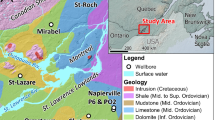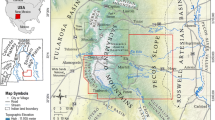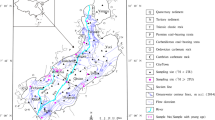Abstract
Measured concentrations of environmental tracers in spring discharge from a karst aquifer in the Shenandoah Valley, USA, were used to refine a numerical groundwater flow model. The karst aquifer is folded and faulted carbonate bedrock dominated by diffuse flow along fractures. The numerical model represented bedrock structure and discrete features (fault zones and springs). Concentrations of 3H, 3He, 4He, and CFC-113 in spring discharge were interpreted as binary dilutions of young (0–8 years) water and old (tracer-free) water. Simulated mixtures of groundwater are derived from young water flowing along shallow paths, with the addition of old water flowing along deeper paths through the model domain that discharge to springs along fault zones. The simulated median age of young water discharged from springs (5.7 years) is slightly older than the median age estimated from 3H/3He data (4.4 years). The numerical model predicted a fraction of old water in spring discharge (0.07) that was half that determined by the binary-dilution model using the 3H/3He apparent age and 3H and CFC-113 data (0.14). This difference suggests that faults and lineaments are more numerous or extensive than those mapped and included in the numerical model.
Résumé
La concentration des traceurs environnementaux mesurée à l’émergence des sources issues d’un aquifère karstique de la Vallée de Shenandoah, USA, a été utilisée pour affiner un modèle d’écoulement souterrain numérique. L’aquifère karstique est un massif calcaire plissé et fracturé, où domine un écoulement diffus le long des fractures. Le modèle numérique représente la structure d’ensemble du massif et les paramètres discontinus (zones de failles et sources). Les concentrations en 3H, 3He, 4He et CFC-113 à l’émergence de la source ont été interprétées comme des mélanges binaires d’une eau jeune (0–8 ans) et d’une eau ancienne (dépourvue de traceur). Les mélanges d’eau souterraine simulés proviennent de l’addition d’une eau jeune suivant un cheminement proche de la surface et d’une eau ancienne qui emprunte un cheminement profond à travers le domaine couvert par le modèle et qui se décharge par des sources le long de la zone de failles. L’âge médian simulé des eaux jeunes émergeant aux sources (5.7 ans) est légèrement plus élevé que celui estimé d’après les données 3H/3He (4.4 ans). Le modèle numérique prédit une fraction d’eau ancienne à l’émergence de la source (0.07) qui est la moitié de celle déterminée par le modèle de mélange binaire utilisant l’âge apparent 3H/3He et les données de 3H et de CFC-113 (0.14). Cette différence suggère que les failles et les linéaments sont plus nombreux ou plus étendus que ceux cartographiés et intégrés au modèle numérique.
Resumen
Se usan las concentraciones medidas de trazadores ambientales en manantiales de descarga de un acuífero kárstico en el Shenandoah Valley, EEUU, para refinar un modelo numérico de flujo de agua subterránea. El acuífero kárstico es un basamento carbonático plegado y fallado dominado por flujo difuso a lo largo de las fracturas. El modelo numérico representó las estructuras del basamento y rasgos discretos (zonas de fallas y manantiales). Se interpretaron las concentraciones de 3H, 3He, 4He, y CFC-113 en la descarga de manantiales como diluciones binarias de agua joven (0–8 años) y de agua vieja (libre de trazadores). Las mezclas simuladas de agua subterránea son obtenidas a partir del agua joven que fluye a lo largo de trayectorias someras, con el agregado de agua vieja que fluye a lo largo de trayectorias más profundas a través del dominio del modelo que descarga en manantiales a lo largo de las zonas de falla. La edad mediana simulada del agua joven descargada de los manantiales (5.7 años) es ligeramente más vieja que la edad mediana estimada a partir de datos de 3H/3He (4.4 años). El modelo numérico predijo una fracción del agua vieja en la descarga de manantiales (0.07) que fue la mitad que la determinada por el modelo de dilución binario usando la edad aparente 3H/3He y los datos de 3H y CFC-113 (0.14). Esta diferencia sugiere que las fallas y lineamientos son más numerosos o extensos que aquellos mapeados e incluidos en el modelo numérico.
摘要
位于美国谢南多厄河谷的出露泉的环境示踪剂实测结果用于修正地下水流数值模型。岩溶含水层碳酸盐基岩的褶皱和断裂主要受断裂带的延伸方向所控制。数值模拟体现了基岩的结构和离散特点(断裂带和出露泉)。泉水流中的3H, 3He,4He和CFC-113的浓度可以理解为二维稀释的年轻的水(0–8年)和年龄较老的水(无示踪剂)。地下水模拟混合物为来自浅水层年轻的水混合深水层中年龄较老的水,通过沿断裂带出露泉的区域模型得出。泉水流(5.7年)中模拟的年轻水中值年龄比3H/3He(4.4 years)测得年龄稍老。数值模拟预测了一部分(0.07)年龄较老的泉水流,是3H/3He显示年龄、3H和 CFC-113数据通过二维稀释模型计算后结果的一半。这样的结果差异表明,断层和轮廓比数值模拟中反映和包含的更为大量和广泛。
Resumo
Dados de concentração de traçadores ambientais medidos na descarga de uma nascente de um aquífero cársico, no Vale do Shenandoah, EUA, foram usados para refinar um modelo numérico de fluxo de águas subterrâneas. O aquífero cársico é constituído por bedrock dobrado e fraturado e é dominado por fluxo difuso ao longo de fraturas. O modelo numérico representa formações do bedrock e elementos singulares (zonas de falhas e nascentes). As concentrações de 3H, 3He, 4He e de CFC-113 na descarga da nascente foram interpretadas como diluições binárias de água jovem (0–8 anos) e água antiga (livre de traçadores). Misturas simuladas de água subterrânea são derivadas de água jovem que flúi ao longo de caminhos subsuperficiais, com a adição de água mais antiga que flúi através de caminhos mais profundos, através do domínio do modelo que descarrega nas nascentes ao longo das falhas. A mediana das idades das águas recentes descarregadas nas nascentes (5.7 anos) é ligeiramente mais antiga do que a mediana das idades estimadas pela relação 3H/3He (4.4 anos). O modelo numérico previu a fração de água antiga na nascente (0.07), a qual é metade da determinada pelo modelo de diluição binário utilizando a idade aparente 3H/3He e os dados de 3H e CFC-113 (0.14). Esta diferença sugere que as falhas e lineamentos são mais numerosos ou extensos do que aqueles que se encontram mapeados e incluídos no modelo numérico.














Similar content being viewed by others
References
Anderman ER, Kipp KL, Hill MC, Valstar J, Neupauer RM (2002) MODFLOW-2000, the U.S. Geological Survey modular ground-water model: documentation of the Model-Layer Variable-Direction Horizontal Anisotropy (LVDA) capability of the Hydrogeologic-Unit Flow (HUF) Package. US Geol Surv Open-File Rep 02–409
Beaudoin G, Therrien R, Savard C (2006) 3D numerical modeling of fluid flow in the Val-d’Or orogenic gold district: major crustal shear zones drain fluids from overpressured vein fields. Miner Deposita 41:82–98
Bethke CM, Johnson TM (2008) Groundwater age and groundwater age dating. Annu Rev Earth Planet Sci 36:121–152
Blessent D, Therrien R, Gable CW (2011) Large-scale simulation of groundwater flow and solute transport in discretely-fractured crystalline bedrock. Adv Water Resour 34:1539–1552
Butts C (1940) Geology of the Appalachian Valley in Virginia. Part 1, Geologic text and illustrations. Virginia Geol Surv Bull 52
Cady RC (1936) Ground-water resources of the Shenandoah Valley, Virginia. Virginia Geol Surv Bull 45
Cook PG, Love AJ, Robinson NI, Simmons CT (2005) Groundwater ages in fractured rock aquifers. J Hydrol 308:284–301
Davis JH, Katz BG (2007) Hydrogeologic investigation, water chemistry analysis, and model delineation of contributing areas for City of Tallahassee public-supply wells, Tallahassee, Florida. US Geol Surv Sci Invest Rep 2007-5070
Dean SL, Kulander BR, Lessing P, Barker D (1987) Geology of the Hedgesville, Keedysville, Martinsburg, Shepherdstown, and Williamsport quadrangles, Berkeley and Jefferson Counties, West Virginia. West Virginia Geol Econ Surv Map-WV31. scale 1:24,000
Dean SL, Lessing P, Kulander BR, Barker D (1990) Geology of the Berryville, Charles Town, Harpers Ferry, Middleway, and Round Hill quadrangles, Berkeley and Jefferson Counties, West Virginia. West Virginia Geol Econ Surv Map-WV35. scale 1:24,000
Doctor DH, Orndorff W, Orndorff RC (2009) Overview of the Shenandoah Valley karst of Virginia and West Virginia. In: Stafford KW, Fratesi B (eds) Guidebook for excursion No. 1, coast to coast excursion, eastern segment, July 27 to August 5, 2009 excursion guidebook for the Fifteenth International Congress of Speleology of the International Union of Speleology. Greyhound, Huntsville, Al, pp 84–96
Doctor DH, Farrar NC, Herman JS (2011) Interaction between shallow and deep groundwater components at Fay Spring in the northern Shenandoah Valley karst. USGS Karst Interest Group Proceedings, Fayetteville, Arkansas, April 26–29. US Geol Surv Sci Invest Rep 2011-5031:25–34
Eberts SM, Bohlke JK, Kauffman LJ, Jurgens BC (2012) Comparison of particle-tracking and lumped-parameter age-distribution models for evaluating vulnerability of production wells to contamination. Hydrogeol J 20:263–282
Einsiedl F, Radke M, Maloszewski P (2010) Occurrence and transport of pharmaceuticals in a karst groundwater system affected by domestic wastewater treatment plants. J Contam Hydrol 117:26–36
Hanson RT, Kauffman LJ, Hill MC, Dickinson JE, Mehl SW (2012) Documentation of the MODPATH observation process, with support for local grid refinement and four types of observations and predictions. US Geol Surv Tech Methods 6–A42
Harbaugh AW, Banta ER, Hill MC, McDonald MG (2000) MODFLOW-2000, the US Geological Survey modular ground-water model: user guide to modularization concepts and the groundwater flow process. US Geol Surv Open-File Rep 00–92
Harlow Jr GE, Orndorff RC, Nelms DL, Weary DJ, Moberg RM (2005) Hydrogeology and ground-water availability in the carbonate aquifer system of Frederick County, Virginia. US Geol Surv Sci Invest Rep 2005-5161
Hatcher Jr RD, Thomas WA, Geiser PA, Snoke AW, Mosher S, Wiltschko DV (1989) Alleghanian orogeny. In: Hatcher RD Jr, Thomas WA, Viele GW (eds) The Appalachian-Ouachita Orogen in the United States: the geology of North America, vol F-2. Geological Society of America, Boulder, CO
Hobba Jr WA, Fisher DW, Pearson FJ Jr, Chemerys JC (1979) Hydrology and geochemistry of thermal springs of the Appalachians. US Geol Surv Prof Pap 1044-E
Hubbard DA Jr, Giannini WF, Lorah MM (1985) Travertine-marl deposits of the Valley and Ridge Province of Virginia: a preliminary report. Virginia Miner 31(1):1–16
International Atomic Energy Agency (IAEA) (2006) Use of chlorofluorocarbons in hydrology: a guidebook. STI/PUB/1238. http://www-pub.iaea.org/MTCD/publications/PDF/Pub1238_web.pdf. Accessed on 3 April 2013
International Atomic Energy Agency (IAEA) (2012) Isotope Hydrology Section, Global Network of Isotopes in Precipitation (GNIP), IAEA, Vienna. http://www-naweb.iaea.org/napc/ih/IHS_resources_gnip.html. Accessed on 3 April 2013
Jones WK, Deike GH, III (1981) A hydrogeologic study of the watershed of the National Fisheries Center at Leetown, West Virginia. Report prepared for the US Fish and Wildlife Service by Environmental Data, Frankford, WVA, 84 pp
Jones WK (1991) The carbonate aquifer of the Northern Shenandoah Valley of Virginia and West Virginia. In: Kastning EH, Kastning KM (eds) Proceedings of the Appalachian Karst Symposium, Radford VA, 23–26 March 1991, pp 217–222
Jones WK (1997) Karst hydrology atlas of West Virginia. Special Publ. no. 4, Karst Waters Institute, Charles Town, West VA
Kozar MD, Weary DJ (2009) Hydrogeology and ground-water flow in the Opequon Creek watershed area, Virginia and West Virginia. US Geol Surv Sci Invest Rep 2009-5153
Kozar MD, McCoy KJ, Weary DJ, Field MS, Pierce HA, Schill WB, Young JA (2007) Hydrogeology and water quality of the Leetown Area, West Virginia. US Geol Surv Open-File Rep 2007-1358
Lindgren RJ, Houston NA, Musgrove M, Fahlquist LS, Kauffman LJ (2011) Simulations of groundwater flow and particle-tracking analysis in the zone of contribution to a public-supply well in San Antonio, Texas. US Geol Surv Sci Invest Rep 2011-5149
Long AJ, Putnam LD (2009) Age-distribution estimation for karst groundwater: issues of parameterization and complexity in inverse modeling by convolution. J Hydrol 376:579–588
McCoy KJ, Kozar MD (2008) Use of sinkholes and specific capacity distributions to assess vertical gradients in a karst aquifer. Environ Geol 54:921–935
McCoy KJ, Podwysocki MH, Crider EA, Weary DJ (2005a) Fracture trace map and single-well aquifer test results in a carbonate aquifer in Berkeley County, West Virginia. US Geol Surv Open-File Rep 2005-1040
McCoy KJ, Podwysocki MH, Crider EA, Weary DJ (2005b) Fracture trace map and single-well aquifer test results in a carbonate aquifer in Jefferson County, West Virginia. US Geol Surv Open-File Rep 2005-1407
Michel RL (1989) Tritium deposition over the continental United States, 1953–1983. In: Delleur JW (ed) Atmospheric deposition. International Association of Hydrological Sciences, Wallingford, UK, pp 109–115
Nelms DL, Moberg RM (2010) Hydrogeology and groundwater availability in Clarke County, Virginia. US Geol Surv Sci Invest Rep 2010-5112
Nelms DL, Harlow GE Jr, Hayes DC (1997) Base-flow characteristicsof streams in the Valley and Ridge, the Blue Ridge, andthe Piedmont physiographic provinces of Virginia. US Geol Surv Water Suppl Pap 2457
Neumann RB, LaBolle EM, Harvey CF (2008) The effects of dual-domain mass transfer on the tritium-helium-3 dating method. Environ Sci Technol 42:4837–4843
Perry LD, Costain JK, Geiser PA (1979) Heat flow in western Virginia and a model for the origin of thermal springs in the folded Appalachians. J Geophys Res 84(B12):6875–6883
Poeter EP, Hill MC (1998) Documentation of UCODE, A computer code for universal inverse modeling. US Geol Surv Water Res Invest Rep 98-4080
Poeter EP, Hill MC, Banta ER, Mehl, S, Christensen S (2005) UCODE_2005 and six other computer codes for universal sensitivity analysis, calibration, and uncertainty evaluation. US Geol Surv Tech Methods 6-A11
Pollock D (1994) User’s guide for MODPATH/MODPATH-PLOT, version 3: a particle tracking post-processing package for MODFLOW, the U. S. Geological Survey finite-difference ground-water flow model. US Geol Surv Open-File Rep 94-464
Sanford WE, Plummer LN, McAda DP, Bexfield LM, Anderholm SK (2004) Hydrochemical tracers in the Middle Rio Grande Basin, USA: 2. calibration of a ground-water flow model. Hydrogeol J 12(4):389–407
Sanford W (2011) Calibration of models using groundwater age. Hydrogeol J 19:13–16
Scanlon BR, Mace RE, Barrett ME, Smith B (2003) Can we simulate regional groundwater flow in a karst system using equivalent porous media models? Case study, Barton Springs Edwards aquifer, USA. J Hydrol 276:137–158
Schlosser P, Stute M, Dorr H, Sonntag C, Munnich KO (1988) Tritium/3He dating of shallow groundwater. Earth Planet Sci Lett 89:353–362
Schlosser P, Stute M, Dorr H, Sonntag C, Munnich KO (1989) Tritiogenic 3He in shallow groundwater. Earth Planet Sci Lett 94:245–256
Senior LA, Goode DJ (1999) Ground-water system, estimation of aquifer hydraulic properties, and effects of pumping on groundwater flow in Triassic sedimentary rocks in and near Lansdale, Pennsylvania. US Geol Surv Water Res Invest Rep 99-4228
Shapiro AM (2001) Effective matrix diffusion in kilometer-scale transport in fractured crystalline rock. Water Resour Res 37(3):507–522
Shapiro AM (2011) The challenge of interpreting environmental tracer concentrations in fractured rock and carbonate aquifers. Hydrogeol J 19:9–12
Schuster ET, White WB (1971) Seasonal fluctuations in the chemistry of limestone springs: a possible means for characterizing carbonate aquifers. J Hydrol 14:93–128
Solomon DK, Genereux DP, Plummer LN, Busenberg E (2010) Testing mixing models of old and young groundwater in a tropical lowland rain forest with environmental tracers. Water Resour Res 46, W04518. doi:10.1029/2009WR008341
Tiedeman CR, Lacombe PJ, Goode DJ (2010) Multiple well-shutdown tests and site-scale flow simulation in fractured rocks. Ground Water 48(3):401–415
Therrien R, Sudicky EA (1996) Three-dimensional analysis of variably-saturated flow and solute transport in discretely fractured porous media. J Contam Hydrol 23:1–44
Trapp H, Jr, Horn MA (1997) Ground Water Atlas of the United States, Delaware, Maryland, New Jersey, North Carolina, Pennsylvania, Virginia, West Virginia. US Geol Surv Hydrol Atlas HA 730-L
Troldberg L, Jensen KH, Engesgaard P, Refsgaard JC, Hinsby K (2008) Using environmental tracers in modeling flow in a complex aquifer system. J Hydrol Eng 13(11):1037–1048
US Department of Commerce (2012) National Oceanic and Atmospheric Administration (NOAA), Earth System Research Laboratory, Global Monitoring Division, Boulder, CO, USA. Available at http://www.esrl.noaa.gov/gmd/. Accessed on 3 April 2012
US Department of Energy (2012) DOE, Carbon Dioxide Information Analysis Center (CDIAC). Oak Ridge National Laboratory (ORNL), Oak Ridge, TN, USA. Available at http://cdiac.esd.ornl.gov/. Accessed on 3 April 2013
US Geological Survey (2012) US Geological Survey, Reston Chlorofluorocarbon Laboratory. US Geological Survey, Reston, VA. Available at http://water.usgs.gov/lab/chlorofluorocarbons/sampling/.Accessed on 3 April 2013
Weary DJ (2008) Preliminary Map of potentially karstic carbonate rocks in the central and southern Appalachian states. US Geol Surv Open-File Rep 2008-1154
Weissmann GS, Zhang Y, LaBolle EM, Fogg GE (2002) Dispersion of groundwater age in an alluvial aquifer system. Water Res Res 38(10):1198–1211
Worthington SRH (2009) Diagnostic hydrogeologic characteristics of a karst aquifer (Kentucky, USA). Hydrogeol J 17:1665–1678
Wright WG (1990) Groundwater hydrology and quality in the Valley and Ridge and Blue Ridge physiographic provinces of Clarke County, Virginia, US Geol Surv Water Res Invest Rep 90-4134
Wu Q, Zhou W, Pan G, Ye S (2009) Application of a discrete-continuum model to karst aquifers in North China. Ground Water 47(3):453–461
Yager RM (1996) Simulated three-dimensional ground-water flow in the Lockport Group, a fractured-dolomite aquifer near Niagara Falls, New York. US Geol Surv Water Supply Pap 2487
Yager RM, Ratcliffe NM (2010) Hydrogeology and simulation of groundwater flow in fractured rock in the Newark Basin, Rockland County, New York. US Geol Surv Sci Invest Rep 2010-5250
Yager RM, Voss CI, Southworth S (2009) Comparison of alternative representations of hydraulic-conductivity anisotropy in folded fractured-sedimentary rock: modeling groundwater flow in the Shenandoah Valley (USA). Hydrogeol J 17(5):1111–1131
Zheng C, Bennett GD (2002) Applied contaminant transport modeling. Wiley, New York
Acknowledgements
Information required to construct and calibrate the groundwater flow model described in this study was provided by USGS colleagues G. Harlow, K. McCoy, J. Pope and J. Eggleston, D. Weary, and Mark Kozar. The manuscript was improved by comments from reviewers, including S. Eberts, K. McCoy, A. Massoudieh and W.P. Gardner. We thank Allen Shapiro and D. Goode who assisted with numerical simulations pertaining to the effects of exchange between mobile and immobile waters on environmental tracer concentrations. This study was supported by the USGS Groundwater Resources Program and the USGS National Research Program. Any use of trade, firm, or product names is for descriptive purposes only and does not imply endorsement by the US Government.
Author information
Authors and Affiliations
Corresponding author
Electronic supplementary material
Below is the link to the electronic supplementary material.
ESM 1
(PDF 339 kb)
Rights and permissions
About this article
Cite this article
Yager, R.M., Plummer, L.N., Kauffman, L.J. et al. Comparison of age distributions estimated from environmental tracers by using binary-dilution and numerical models of fractured and folded karst: Shenandoah Valley of Virginia and West Virginia, USA. Hydrogeol J 21, 1193–1217 (2013). https://doi.org/10.1007/s10040-013-0997-9
Received:
Accepted:
Published:
Issue Date:
DOI: https://doi.org/10.1007/s10040-013-0997-9




